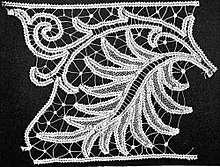Battenberg lace
Battenberg lace is a type of tape lace. It was frequently used as an edging, and was particularly popular in the United States in the 19th century.[1] The name for this American lace was chosen in honour of a wedding of the Battenberg family, which occurred about the time a patent for making the lace was applied for in Washington, D.C. 19th-century tape laces use inexpensive machine-woven tape as the outline, and the availability of this commercial tape led to increased popularity of Battenberg lace.[2] Originally Battenberg lace was heavier than the other machine tape laces such as Princess lace.[3] Some regard Battenberg lace as a type of Renaissance lace.[4] Others regard Renaissance Lace as a different type of tape lace.[5]

By the end of the 1800s, a wide variety of tapes and patterns were available for purchase from companies such as Butterick, Sears, and Montgomery Ward.[2]:20

References
| Wikimedia Commons has media related to Battenberg (needle lace). |
- Bath, Virginia Churchill (1979). Lace. Harmondsworth, Eng.: Penguin Books. p. 292. ISBN 0-14-046378-X. OCLC 4494296.
- Stitchery and needle lace from Threads magazine. Newtown, CT: Taunton Press. 1991. ISBN 1-56158-010-4. OCLC 23356646.
- The Art of Modern Lace-making. Butterick Publishing Co. 1891.
- Pat Earnshaw. A Dictionary of Lace. Shire Publications. ISBN 0-85263-700-4.
- The Lace Guild. "Tape Lace". Archived from the original on 2015-02-15. Retrieved 26 November 2014.
